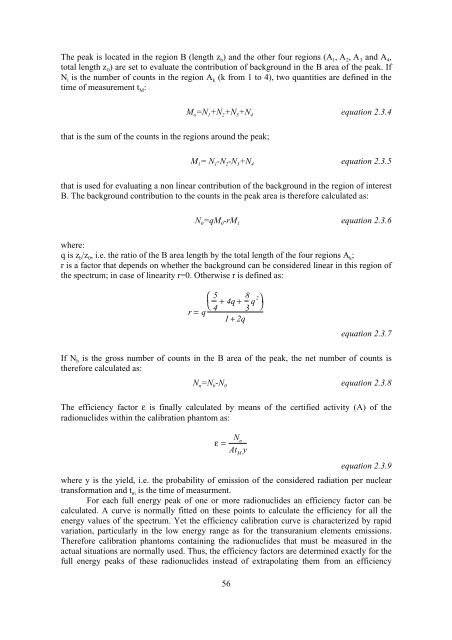Plutonium Biokinetics in Human Body A. Luciani - Kit-Bibliothek - FZK
Plutonium Biokinetics in Human Body A. Luciani - Kit-Bibliothek - FZK
Plutonium Biokinetics in Human Body A. Luciani - Kit-Bibliothek - FZK
You also want an ePaper? Increase the reach of your titles
YUMPU automatically turns print PDFs into web optimized ePapers that Google loves.
The peak is located <strong>in</strong> the region B (length z b) and the other four regions (A 1, A 2, A 3 and A 4,<br />
total length z 0) are set to evaluate the contribution of background <strong>in</strong> the B area of the peak. If<br />
N i is the number of counts <strong>in</strong> the region A k (k from 1 to 4), two quantities are def<strong>in</strong>ed <strong>in</strong> the<br />
time of measurement t M:<br />
M o=N 1+N 2+N 3+N 4<br />
that is the sum of the counts <strong>in</strong> the regions around the peak;<br />
M 1= N 1-N 2-N 3+N 4<br />
56<br />
equation 2.3.4<br />
equation 2.3.5<br />
that is used for evaluat<strong>in</strong>g a non l<strong>in</strong>ear contribution of the background <strong>in</strong> the region of <strong>in</strong>terest<br />
B. The background contribution to the counts <strong>in</strong> the peak area is therefore calculated as:<br />
N 0=qM 0-rM 1<br />
equation 2.3.6<br />
where:<br />
q is z b/z 0, i.e. the ratio of the B area length by the total length of the four regions A k;<br />
r is a factor that depends on whether the background can be considered l<strong>in</strong>ear <strong>in</strong> this region of<br />
the spectrum; <strong>in</strong> case of l<strong>in</strong>earity r=0. Otherwise r is def<strong>in</strong>ed as:<br />
5 8<br />
+ 4q +<br />
r = q<br />
4 3 ⎛<br />
⎝<br />
1 + 2q<br />
q 2<br />
⎞<br />
⎠<br />
equation 2.3.7<br />
If N b is the gross number of counts <strong>in</strong> the B area of the peak, the net number of counts is<br />
therefore calculated as:<br />
N n=N b-N 0 equation 2.3.8<br />
The efficiency factor ε is f<strong>in</strong>ally calculated by means of the certified activity (A) of the<br />
radionuclides with<strong>in</strong> the calibration phantom as:<br />
ε = N n<br />
At M y<br />
equation 2.3.9<br />
where y is the yield, i.e. the probability of emission of the considered radiation per nuclear<br />
transformation and t m is the time of measurment.<br />
For each full energy peak of one or more radionuclides an efficiency factor can be<br />
calculated. A curve is normally fitted on these po<strong>in</strong>ts to calculate the efficiency for all the<br />
energy values of the spectrum. Yet the efficiency calibration curve is characterized by rapid<br />
variation, particularly <strong>in</strong> the low energy range as for the transuranium elements emissions.<br />
Therefore calibration phantoms conta<strong>in</strong><strong>in</strong>g the radionuclides that must be measured <strong>in</strong> the<br />
actual situations are normally used. Thus, the efficiency factors are determ<strong>in</strong>ed exactly for the<br />
full energy peaks of these radionuclides <strong>in</strong>stead of extrapolat<strong>in</strong>g them from an efficiency












![{A1[]Sp - Bibliothek](https://img.yumpu.com/21908054/1/184x260/a1sp-bibliothek.jpg?quality=85)




